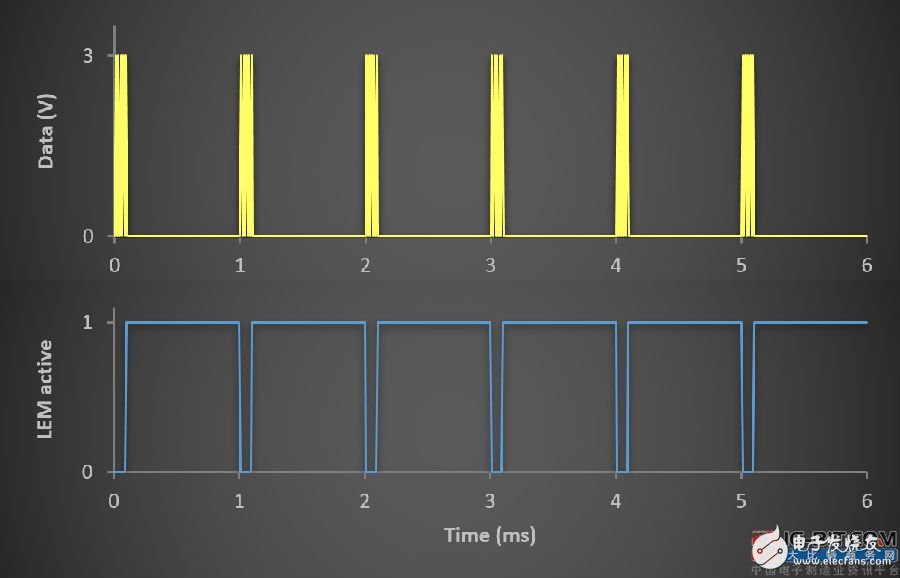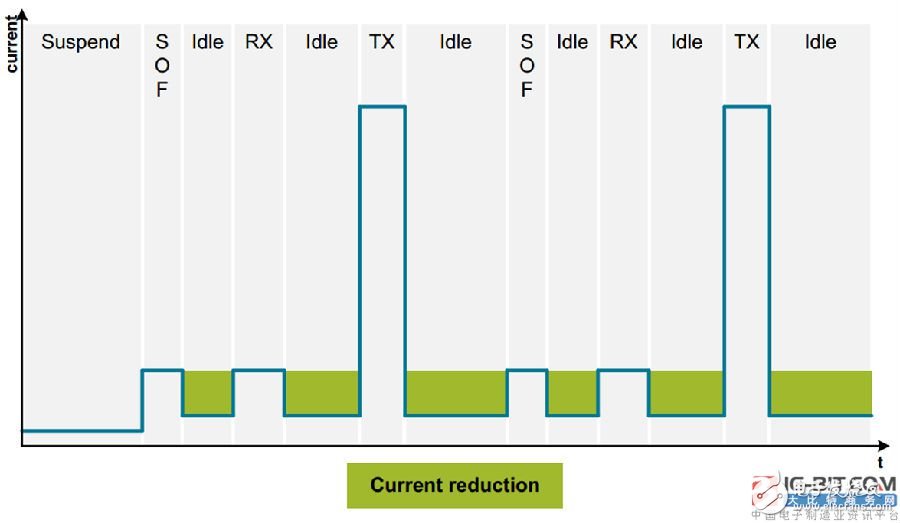Over the past decade, the Universal Serial Bus (USB) standard has been used by designers of many industrial and consumer electronics as the interface of choice for connecting other applications due to its ease of use, plug-and-play functionality, and reliability. USB has achieved its primary goal of providing consumers with ways to simplify controlling peripherals and transferring data. With more than three billion USB-enabled devices entering the market, USB is not only the fastest growing interface in consumer applications, it has also achieved significant growth in the industrial market.
However, USB's ease of use, plug-and-play functionality and reliability are not at all a cost to embedded solution designers, especially if they are designing power-sensitive, battery-powered connections for the IoT. Equipment products. For a small, portable device, adding USB as a communication interface at least doubles the application current consumption and results in the device needing a larger battery than originally expected.
Upgrading from traditional serial interface communications to popular USB interfaces often becomes difficult due to power budget constraints. In general, designers have to choose between increasing double battery capacity and increasing equipment costs (which makes it less attractive), or eliminating much-needed differentiation. Let's take a look at how the USB standard has evolved from the dream of standardizing all PC connections to the most advanced technology that allows even small IoT battery-powered devices to communicate with any other device.
A brief history of USBIf you have studied the back of a desktop computer manufactured in the late 1990s, you will be able to recognize at a glance the many standards that appear to connect different types of hardware to computers. These connection standards include 5-pin DIN, PS/2, serial, parallel, and perhaps one or two SCSI ("scuzzy") ports. If you are a game player, you will also have a game port on the sound card.
Earlier developers of USB realized this chaotic connection and in 1995 began to create a common standard for machine-to-machine (M2M) to replace all other interface standards. In the late 1990s, when USB was first adopted, it was added to the PC as an "other connector." However, USB began to develop rapidly in 2000, and after a series of updates, it became one of the most widely used M2M interfaces. Just look at your laptop and cell phone to understand how successful the USB standard is. Your smart phone has only one connector interface: USB. If you purchase a laptop after 2010, you may find that in addition to the monitor and network connector, it may only have a USB interface. In addition, touchpads, keyboards, and other peripherals used in today's laptops and tablets communicate with the host processor via USB.
The USB standard topology is divided into device and host. The host is the machine that initiates the communication and provides power; on the desktop, it is usually your laptop or desktop PC. The device is a downstream device connected to the host, simply responding to any request from the host; on the desktop, the mouse and keyboard are common USB devices.
The unique thing about the USB connector is that it can also power the connected device, so there is no need to add extra power to your mouse or external hard drive. The USB standard specifies that the host outputs at least 100 mA of current to the device, and if the device supports it, it is possible to obtain 500 mA of current. These power supplies come from the original USB standard. PCs are almost always hosts, and they always receive power through wall outlets. This USB standard requirement greatly limits the development of USB in low-power applications, although the main power supply is not a problem for PC applications.
But what happens when this mature M2M interface meets today's battery-powered IoT world? When the host is also a portable device, what impact does it have?
Impact on today's USB hardwareIn today's portable device applications, the most common term is "power budget." The power budget determines how much energy the device can consume, and it is calculated based on the battery capacity and the required battery life. For example, in an application that has a 250mA battery capacity and needs to support two days (48 hours) of battery life, the power budget is approximately 5mA. This power budget must be distributed across every function the developer wants the device to do, from sensor acquisition and processing to communication and driver display.
In the past two or three decades, microcontrollers (MCUs) have become smaller and smaller, and battery capacity has also improved. As a result, we have witnessed explosive growth in portable devices. These portable devices include handheld anemometers and oscilloscopes. To digital breathalyzer and remote control. However, with the advent of smartphones with four gigahertz core processors, we now see more portable devices appearing as smart phone accessories, and manufacturers no longer worry about processing power or user interface issues. This market trend is driving rapid growth of low-cost accessories such as the Vaavud anemometer, which is available for Kickstarter fundraising support for smartphones, and breathalyzers that can be plugged into the iPhone. Both applications use the HiJack interface. This special interface can work on low-end devices, but it is not the best interface.
In order to design a truly universal and easy-to-use portable device, you should choose the most suitable M2M interface, such as USB. Selecting USB also allows your design product to be host-agnostic, which means that if you want your product to support both Macs, Windows phones, and Android tablets, this is no longer a problem. However, when you want to connect these gadgets to your battery-powered everyday items via USB, the "power consumption" you never cared about in the original USB standard suddenly became a priority for choosing a USB solution. You don't want to waste the precious battery life of your tablet or laptop just to communicate with on-board peripherals, and you don't want to design an accessory application that will quickly deplete your smartphone's battery.
By choosing the right USB-enabled hardware, you will be able to develop devices that consume very little energy, while the universal M2M interface eliminates almost any external device.
USB technology for battery-powered worldTo understand how USB technology can improve power consumption while maintaining ease of use and plug-and-play functionality, we first need to quickly review the USB communication process. In general, only the host can initiate the transmission. Even if there is no communication, the host must send a keep-alive message to the device every millisecond. If the device has data available, it responds. In this active mode, the device can obtain up to 100mA of energy, and the host expects the device to immediately respond to any request. When the host stops sending these keep-alive messages for 3ms, the device should go into a suspend state and immediately reduce its current consumption to below 3mA.
In the suspended state, most devices can be turned off. Usually we can turn off the most energy-consuming PHY components. Even though modern MCUs can easily achieve a 3 mA suspend current, we have no reason to stay at that high level. MCUs with good energy modes should be able to achieve current consumption of less than 3μA in this mode, including the current consumption of the PHY.
However, in the active mode, the active mode is not very effective when detecting the USB communication of a conventional keyboard device; most of the time, the device only waits for the host to send data. However, when the host requests a device response, the response must be timely; this is why most implementations keep USB peripherals running at 48 MHz to allow sufficient response time. In this particular example, 97% of the time is idle, even if we enumerate and activate.
A USB application optimized for battery-powered applications takes these power management factors into account and determines exactly when the clock is needed, how long it takes, and which other USB components can be turned off. Silicon Labs currently has two pending patent technologies and has received feedback from manufacturers and customers, making the USB interface truly useful in today's battery-powered IoT devices. Even in the active mode, energy-efficient communications can be achieved by using a power-free USB connection between the crystal-free USB oscillator and closing packet communications, as shown in Figure 1. This innovative approach significantly reduces system-level energy consumption and creates a truly universal M2M interface that provides superior energy efficiency.

Figure 1: A valid signal with the low-energy mode (LEM) keyboard transmission bus indicates when the power-consuming USB interface unit is turned off.
Of course, low-power USB should be implemented invisible to developers and end users. With low energy mode (LEM), reducing power consumption is very obvious, as shown in Figure 2. When this technology is combined with other space and cost-saving features such as crystal-free USB applications and clock recovery, developers can implement a truly ultra-low power universal M2M interface without the need for additional devices.

Figure 2: A typical USB transceiver is in "receive" mode when idle, wasting 3-5mA. With LEM technology, the transceiver can remain in a low-current mode like suspend.
to sum upThe USB interface has evolved from a simple need to reduce messy cable connections on traditional desktop PCs to the standard for consumer electronics devices. The proliferation of USB-enabled portable devices has forced integrated USB peripherals to provide new design requirements.
New smart USB hardware reduces cost and power consumption and extends battery life. When combined with crystal-free USB technology, the widely used USB standard will make all connectable devices smarter, connectable, and energy-efficient.
Terminals can be divided into UK terminal, European terminal series, plug-in terminal series, transformer terminal, building wiring terminal, fence type terminal series, spring type terminal series, rail type terminal series, through the wall Type terminal series.It is able to achieve safe, reliable and effective connection, especially in the environment of high current and high voltage.
Barrier Terminal Blocks,Barrier Pcb Screw Terminal Block,Waterproof Barrier Terminal Blocks,Panel Mount Barrier Terminal Block
Sichuan Xinlian electronic science and technology Company , https://www.sztmlchs.com